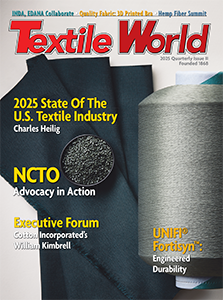An effort by the Chinese government to assist its flagging textile industry has triggered a strong
reaction from US manufacturers who fear it could contribute to a surge in imports after all quotas
on Chinese imports expire December 31.
When textile and apparel exports fell during the first quarter of this year by 11 percent to
$82 billion, the Chinese government decided to increase its export tax rebates for textiles and
apparel from 14 percent to 17 percent. That action was taken after what Premier Wen Jiabao cited as
a “serious and unprecedented situation due to economic changes at home and abroad.”
Reacting to the tax rebate announcement, Cass Johnson, president of the National Council of
Textile Organizations, said: “By dramatically increasing subsidies just prior to the phase-out of
quotas, China has thrown down a gauntlet that the US government and the US Congress cannot ignore.”
Johnson said the new tax breaks coupled with two similar increases amounts to an increase of 55
percent since July 2008. He charged that Chinese exporters have seen subsidies from the central
government increase from $19 billion to $29 billion.
Johnson called on the incoming Obama administration to “act swiftly against China” by
self-initiating trade remedy cases if Chinese imports surge once quotas are removed. He noted that
last month, President-elect Barack Obama committed to a textile monitoring program directed at
illegal trade activities. He also urged the new administration to consider taking complaints of
illegal textile trade to the World Trade Organization.
In addition, he urged Congress to enact legislation addressing what the textile industry and
others believe is a major subsidy resulting from currency manipulation in order to gain an
advantage in international trade.
Johnson said the current trade deficit with China (January through September) has risen
to $195.4 billion from $187.6 billion in 2007.
November 25, 2008








